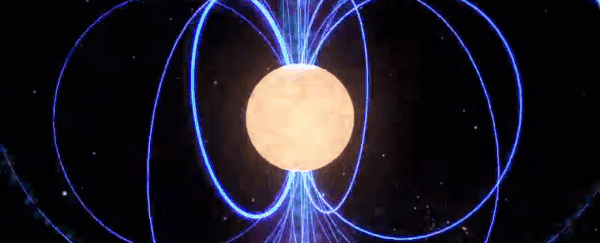After 14 years of staring at a dead star, astronomers have once again confirmed Einstein's theory of general relativity. PSR J1906+0746, a pulsar 25,000 light-years away, slightly wobbles as it spins - an effect that could see its pulses disappear from our sky in less than a decade.
It's called precession, a phenomenon predicted by general relativity that has only ever been observed in very few pulsars. The new findings could help us set a limit on the number of binary pulsars in the galaxy, in turn helping us figure out the expected rate of binary neutron star collisions.
Pulsars are perhaps the most useful stars in the sky. They are rapidly spinning neutron stars with jets of bright radio waves emitting from their magnetic poles. As they spin, these beams can sweep past Earth, depending how the star is oriented: a bit like a lighthouse.
They're also incredibly precise, with rotations that can be predicted up to millisecond scales. These so-called millisecond pulsars can keep such precise time that they could guide future space navigation.
But even the majority of pulsars - ones that don't have that millisecond level of precision - are still useful, particularly for tests of general relativity. That's because, according to general relativity, pulsars in binary systems should have a slight axial wobble (think of a slowing-down spinning top). This is axial precession.
Since neutron stars are so dense - 1.4 times the mass of the Sun, packed down into a stellar core just 20 kilometres (12 miles) in diameter - their gravitational intensity is expected to warp space-time.
When the spin orientation isn't aligned properly with the orientation of the binary orbit, this should pull the pulsar's spin into an axial precession. Such misalignment is thought to be caused by, for example, an asymmetric supernova explosion.
So, as the pulsar wobbles on its axis, we should be able to detect changes in its pulse profile.
When PSR J1906+0746 was discovered in 2004, it showed two distinct twisted, or polarised, emissions (beams) per rotation. However, when a team of astronomers led by Gregory Desvignes from the Max Planck Institute for Radio Astronomy went looking in the archival data collected by the Parkes Observatory radio telescope, they found just one beam.
To figure out what was going on with their study subject, between 2005 and 2009 using the Nançay and Arecibo radio telescopes, and between 2012 to 2018 using Arecibo, the team monitored PSR J1906+0746.
When they started observing the star in 2005, they saw both beams per rotation that had been detected in 2004. Gradually, the beam from the star's north pole became weaker; by 2016, it had disappeared entirely.
The team predicted that the polarisation data contained information about the precession of the pulsar. They modelled this data, extending it back in time 50 years, and then compared it to the observational data from the pulsar.
It matched, with an uncertainty level of just five percent, perfectly matching the predictions of general relativity - as well as predictions about the polarisation properties of pulsars published 50 years ago by Venkatraman Radhakrishnan and David Cooke.
The team also realised that Earth's line-of-sight had crossed the pulsar's magnetic pole in a north-to-south direction, meaning they could map the pulsar beam - which in turn allowed them to determine the proportion of the sky illuminated by the beam.
This helps estimate the number of neutron star binaries in the galaxy, which can help determine how many of them should be colliding, producing gravitational waves.
And their model didn't just work backwards. Seeing how it fit the observational data meant they could predict forwards, too. The team believes that the southern beam is also going to disappear from view, sometime around 2028.
It should reappear sometime between 2070 and 2090, with the northern beam reappearing between 2085 and 2105.
"Pulsars can provide tests of gravity that cannot be done in any other way," said astronomer Ingrid Stairs from the University of British Columbia. "This is one more beautiful example of such a test."
The research has been published in Science.
